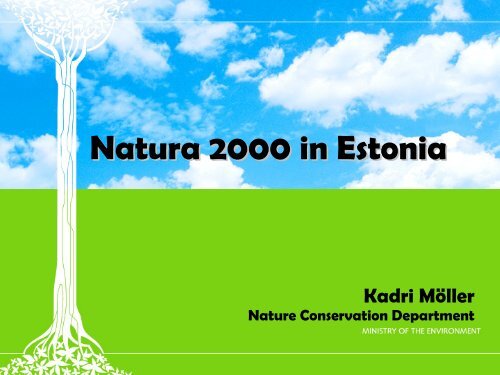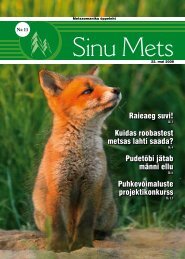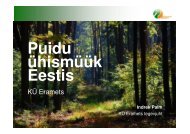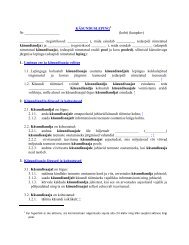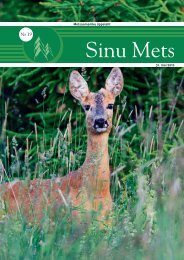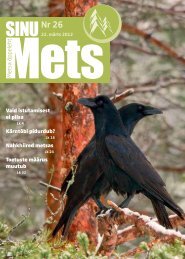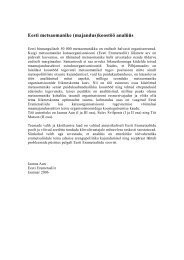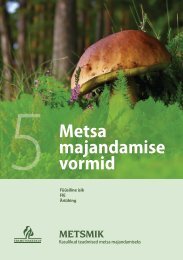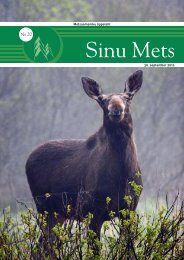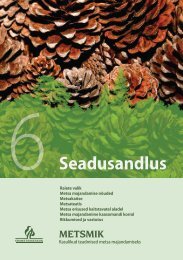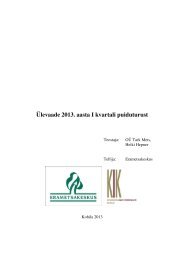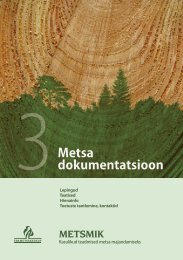Natura 2000 in Estonia
Natura 2000 in Estonia
Natura 2000 in Estonia
You also want an ePaper? Increase the reach of your titles
YUMPU automatically turns print PDFs into web optimized ePapers that Google loves.
<strong>Natura</strong> <strong>2000</strong> <strong>in</strong> <strong>Estonia</strong><br />
Kadri Möller<br />
Nature Conservation Department
<strong>Estonia</strong>n<br />
<strong>Natura</strong> <strong>2000</strong> network<br />
• Birds Directive (2009/147/EC) sites<br />
66 Special Protection Areas (SPA)<br />
total area: 12 590 km2<br />
• Habitats Directive (92/43/EEC) sites<br />
531 (proposed) Sites of Community Importance<br />
(pSCI/SCI)<br />
• 33 pSCI<br />
• 498 SCI<br />
total area: 11 320 km2
<strong>Estonia</strong>n<br />
<strong>Natura</strong> <strong>2000</strong> network<br />
as SPA-s and pSCI-s/SCI-s are mostly overlapp<strong>in</strong>g<br />
total area of<br />
<strong>Estonia</strong>n <strong>Natura</strong> <strong>2000</strong> network<br />
Mar<strong>in</strong>e<br />
14 590 km2<br />
6 585 km2<br />
Terrestrial 7 177 km2 (16.5%)<br />
Forest<br />
Private forest<br />
3 539 km2<br />
866 km2
<strong>Natura</strong> <strong>2000</strong> site protection<br />
All <strong>Estonia</strong>n <strong>Natura</strong> <strong>2000</strong> sites are protected<br />
accord<strong>in</strong>g to Nature Conservation Act as<br />
• Protected areas<br />
− National Parks (5)<br />
− Nature Conservation Areas (120)<br />
− Landscape Protection Areas (233)<br />
• Limited-Conservation Areas (336) (e.g. mar<strong>in</strong>e and<br />
coastal habitats, lakes and rivers, semi-natural grasslands)<br />
• Species Protection Sites (426) (e.g. court<strong>in</strong>g grounds<br />
of capercaillie)
Protection of <strong>Natura</strong> <strong>2000</strong> sites -<br />
area<br />
1%<br />
13%<br />
Natio n al Park s<br />
Natu re C o n s e rvatio n<br />
A re as<br />
51%<br />
4%<br />
17%<br />
14%<br />
L an d s cap e<br />
Pro te ctio n A re as<br />
Sp e cie s Pro te ctio n<br />
Site s<br />
L im ite d -<br />
C o n s e rvatio n A re as<br />
Plan n e d Pro te cte d<br />
A re as
Zones of protected areas<br />
Protected areas are divided<br />
<strong>in</strong>to different zones:<br />
<br />
<br />
<br />
Strict nature reserve (all human activities are<br />
prohibited)<br />
Special management zone (economic activities<br />
are prohibited)<br />
Limited management zone (susta<strong>in</strong>able economic<br />
activities are allowed)
Protection zones (area)<br />
<strong>Natura</strong> <strong>2000</strong><br />
<strong>Natura</strong> <strong>2000</strong> forests<br />
<strong>Natura</strong> <strong>2000</strong> private forests
Protection rules<br />
<br />
<br />
<br />
Protected areas have specific protection rules<br />
approved by the Government<br />
Rules for the protection of Limited-Conservation<br />
Areas are given <strong>in</strong> the Nature Conservation Act<br />
Protection rules for Species Protection Sites are<br />
approved by the M<strong>in</strong>ister of the Environment
Management plans<br />
• Management plans are compiled and<br />
approved by the Environmental Board<br />
• 56 managament plans (1 804 km2 ) are<br />
approved<br />
• 147 management plans (8 504 km2 ) will<br />
be ready by the end of 2010<br />
• The compilation of management plans<br />
for the rest of <strong>Natura</strong> <strong>2000</strong> sites will be<br />
completed by the end of 2013
Designation of Special Areas of Conservation (SAC)<br />
• Accord<strong>in</strong>g to Art 4.4 of the Habitats Directive<br />
once a Site of Community Importance (SCI) has<br />
been adopted by the Commission, the Member<br />
State shall designate the SCI as Special Area of<br />
Conservation (SAC) with<strong>in</strong> 6 years.<br />
• The list of <strong>Estonia</strong>n SCI-s was adopted for the<br />
first time by the Commission Decision of 12 Nov<br />
2007 (2008/24/EC).<br />
• Therefore the designation of Special Areas of<br />
Conservation (SAC) needs to be completed by the<br />
end of 2013.
Designation of SAC (2)<br />
Protection rules (legally b<strong>in</strong>d<strong>in</strong>g):<br />
– Conservation objectives (list of habitats and species)<br />
– Map<br />
– Restrictions<br />
Management plans<br />
– Conservation status of the species and habitats<br />
– Measurable conservation objectives<br />
– Motivation of site designation: habitats and species are<br />
restored or ma<strong>in</strong>ta<strong>in</strong>ed at favourable conservation status<br />
– Threats<br />
– Conservation actions, their priorities<br />
– Timetable<br />
– Budget
<strong>Natura</strong> <strong>2000</strong> and forest<br />
~ 50 % of <strong>Estonia</strong> is covered by forest<br />
~ 20 % of forest is protected (<strong>Natura</strong> <strong>2000</strong>)<br />
Herdis Fridol<strong>in</strong>
Birds Directive and forest<br />
In <strong>Estonia</strong>:<br />
– 66 birds species<br />
listed <strong>in</strong> Annex I of<br />
the Birds Directive<br />
– 20 of them are<br />
forest birds<br />
Egon Niittee
BD Annex I forest species<br />
Eagle Owl - Bubo bubo<br />
Pygmy Owl - Glaucidium passer<strong>in</strong>um<br />
Ural Owl - Strix uralensis<br />
Tengmalm's Owl - Aegolius funereus<br />
Nightjar - Caprimulgus europaeus<br />
Grey-headed Woodpecker - Picus canus<br />
Black Woodpecker - Dryocopus martius<br />
White-backed Woodpecker -<br />
Dendrocopos leucotos<br />
Three-toed Woodpecker – Picoides<br />
tridactylus<br />
Red-breasted Flycatcher – Ficedula<br />
parva<br />
Black Stork - Ciconia nigra<br />
Herdis Fridol<strong>in</strong><br />
White-tailed Eagle –<br />
Haliaetus albicilla<br />
Lesser Spotted Eagle –<br />
Aquila pomar<strong>in</strong>a<br />
Spotted Eagle - Aquila clanga<br />
Golden Eagle - Aquila chrysaetos<br />
Osprey - Pandion haliae"tus<br />
Merl<strong>in</strong> - Falco columbarius<br />
Hazel Grouse - Bonasa bonasia<br />
Black Grouse - Tetrao tetrix<br />
Capercaillie - Tetrao urogallus
Habitats Directive and forests<br />
In <strong>Estonia</strong>:<br />
Habitats Directive Annex I<br />
60 habitat types (<strong>in</strong>cl 18 priority habitats)<br />
e.g. 11 forest habitat types (<strong>in</strong>cl 6 priority types)<br />
Habitats Directive Annex II<br />
51 species (<strong>in</strong>cl 3 priority species):<br />
14 plant species (5 <strong>in</strong> forest)<br />
7 mosses (2 forest)<br />
16 <strong>in</strong>vertebrates (6 forest)<br />
7 fish species<br />
1 amphibian<br />
6 mammals (3 forest)<br />
Uudo Timm
HD Annex I forest habitat types<br />
90. Forests of Boreal Europe<br />
9010 * Western Taiga<br />
9020 * Fennoscandian hemiboreal<br />
natural old broad-leaved deciduous<br />
forests (Quercus,Tilia, Acer,<br />
Frax<strong>in</strong>us or Ulmus) rich <strong>in</strong><br />
epiphytes<br />
9050 Fennoscandian herb-rich forests<br />
with Picea abies<br />
9060 Coniferous forests on, or<br />
connected to, glaciofluvial eskers<br />
9070 Fennoscandian wooded pastures<br />
9080 * Fennoscandian deciduous<br />
swamp woods<br />
Herdis Fridol<strong>in</strong>
HD Annex I forest habitat types (2)<br />
91. Forests of Temperate Europe<br />
9180 * Tilio-Acerion forests of slopes,<br />
screes and rav<strong>in</strong>es<br />
91D0 * Bog woodland<br />
91E0 * Alluvial forests with Alnus<br />
glut<strong>in</strong>osa and Frax<strong>in</strong>us excelsior (Alno-<br />
Padion,Alnion <strong>in</strong>canae, Salicion albae)<br />
91F0 Riparian mixed forests of Quercus<br />
robur, Ulmus laevis and Ulmus m<strong>in</strong>or,<br />
Frax<strong>in</strong>us excelsior or Frax<strong>in</strong>us<br />
angustifolia, along the great rivers<br />
(Ulmenion m<strong>in</strong>oris)<br />
21. Sea dunes of the Atlantic, North Sea<br />
and Baltic coasts<br />
2180 Wooded dunes of the Atlantic,<br />
Cont<strong>in</strong>ental and Boreal region<br />
Herdis Fridol<strong>in</strong>
HD Annex II forest species<br />
Plant species:<br />
Lady s Slipper –<br />
Cypripedium calceolus<br />
Slender Wood Redgrass –<br />
C<strong>in</strong>na latifolia<br />
Sandy P<strong>in</strong>k –<br />
Dianthus arenarius ssp arenarius<br />
Pilose Agrimony – Agrimonia pilosa<br />
Pasque-Flower – Pulsatilla patens<br />
Mosses:<br />
Green Shield-moss –<br />
Buxbaumia viridis<br />
Wood Broom Moss – Dicranum viride<br />
Herdis Fridol<strong>in</strong><br />
Invertebrates:<br />
Boros schneideri<br />
Cuculus c<strong>in</strong>naber<strong>in</strong>us<br />
Hermit Beetle – *Osmoderma eremita<br />
Oxyporus mannerheimii<br />
Scarce Heath – Coenonympha hero<br />
Scarce Fritillary – Euphydryas maturna
HD Annex II forest species<br />
Mammals:<br />
Fly<strong>in</strong>g Squirrel - *Pteromys volans<br />
European M<strong>in</strong>k (Marshotter) - *Mustela lutreola (at forest rivers)<br />
Pond (Rough-legged Water) Bat - Myotis dasycneme<br />
Excemptions of <strong>Estonia</strong>n population from Annex II<br />
Brown Bear – Ursus Arctos<br />
Common (European) Wolf - Canis lupus<br />
Northern Lynx - Lynx lynx<br />
European Beaver - Castor fiber<br />
Herdis Fridol<strong>in</strong>
Habitats Directive Art 17 report<br />
•<br />
In every six years the assessment of conservation<br />
status of each species <strong>in</strong> Annex 2, 4 and 5 and<br />
each habitat <strong>in</strong> Annex 1 shall be made.<br />
•<br />
The first report was made <strong>in</strong> 2007<br />
•<br />
Range, area, trends, reasons for trends, ma<strong>in</strong><br />
pressures and threats were assessed<br />
•<br />
The results:<br />
•<br />
favourable<br />
•<br />
<strong>in</strong>adequate<br />
•<br />
bad<br />
•<br />
unknown<br />
Herdis Fridol<strong>in</strong>
Results of assessment – <strong>Estonia</strong><br />
All habitat types (60) Forest habitat types (11)<br />
13%<br />
8%<br />
42%<br />
Favourable<br />
27%<br />
18%<br />
Favourable<br />
Inadequate<br />
Bad<br />
Inadequate<br />
37%<br />
Unknown<br />
Bad<br />
55%
Results of assessment – <strong>Estonia</strong> (2)<br />
All species (97) Forest species (46)<br />
27%<br />
24%<br />
34%<br />
33%<br />
8%<br />
41%<br />
Favourable<br />
Inadequate<br />
Bad<br />
Unknown<br />
7%<br />
26%<br />
Favourable<br />
Inadequate<br />
Bad<br />
Unknown
National compensationsc<br />
Reduced land tax<br />
50 % or 100% depend<strong>in</strong>g<br />
on the extent of the<br />
restrictions.<br />
Acquisation of land by state<br />
State will buy the land<br />
parcel if its <strong>in</strong>tended use is<br />
significantly limited by the<br />
protection rules.
EU Funds<br />
• European Regional<br />
Development Fund<br />
(ERDF)<br />
• European<br />
Agricultural Fund<br />
for Rural<br />
Development<br />
(EAFRD)<br />
• Life+<br />
Voldemar Rannap
European Regional Development Fund<br />
21.7 MEUR for nature conservation <strong>in</strong> 2007-2013<br />
Activities:<br />
• Preparation of management plans for <strong>Natura</strong> <strong>2000</strong><br />
• Implementation of management plans:<br />
– Habitats restoration<br />
– Infrastructure for habitats restoration or<br />
management<br />
– Infrastructure for improv<strong>in</strong>g oppurtunities<br />
for visitors<br />
• Control of non-native species
European Agricultural Fund for Rural Development<br />
<strong>Estonia</strong>n Rural Development Plan:<br />
•<br />
<strong>Natura</strong> <strong>2000</strong> support to private forest owners<br />
110 EUR/ha per year, 60 EUR/ha per year<br />
•<br />
<strong>Natura</strong> <strong>2000</strong> support to agricultural land user<br />
32 EUR/ha per year<br />
•<br />
Support for the ma<strong>in</strong>tanance of semi-natural<br />
habitats<br />
238 EUR/ha per year, 186 EUR/ha per year<br />
In total more than 6.4 MEUR per year
<strong>Natura</strong> <strong>2000</strong> support to private forest owners<br />
Aim of the support: to compensate the loss of<br />
economic <strong>in</strong>come of the forest result<strong>in</strong>g from the<br />
restrictions of the Birds and Habitats Directives<br />
Area-based support<br />
Two rates:<br />
– 110 EUR/ha per year<br />
– 60 EUR/ha per year<br />
depends on the extent of restrictions
<strong>Natura</strong> <strong>2000</strong> support to private forest owners (2)<br />
<br />
<br />
<br />
<br />
<br />
<br />
<br />
In order to achieve the favourable conservation status for the most<br />
boreal forest types, all forestry activities, except for restoration are<br />
forbidden.<br />
It is very important to compensate the loss of <strong>in</strong>come to the private<br />
forest owners.<br />
Area-based subsidies are paid for compensation.<br />
The problem is that the requirements for area-based subsidies of<br />
forests are practically the same as for open landscapes (fields).<br />
It is much more complicated to measure the exact declared area <strong>in</strong><br />
the forest.<br />
In order to measure the declared area, the landowner needs to<br />
mark it <strong>in</strong> the forest.<br />
The mark<strong>in</strong>g has caused many problems for the landowners and its<br />
not help<strong>in</strong>g to improve the state of biodiversity.
For example the<br />
brown bear may<br />
not like either when<br />
there are too many<br />
marked trees <strong>in</strong> the<br />
forest. It might<br />
decide to go and<br />
f<strong>in</strong>d a better place<br />
to live.<br />
Toomas Tiivel
Example of private land <strong>in</strong> <strong>Natura</strong> <strong>2000</strong> forest
<strong>Natura</strong> <strong>2000</strong> support to private forest owners (3)<br />
• We propose that for the next f<strong>in</strong>anc<strong>in</strong>g period the<br />
requirements for forest area based subsidies would be<br />
re-evaluated to take <strong>in</strong>to account the conditions of the<br />
forest land (e.g. <strong>in</strong> dense forest habitats types).<br />
• The best solution would be the possibility to measure<br />
the compensated area by us<strong>in</strong>g GIS. The controls on<br />
spot will determ<strong>in</strong>e whether the conservation rules are<br />
followed.<br />
• If there is an <strong>in</strong>fr<strong>in</strong>gement, the exact location will be<br />
determ<strong>in</strong>ed.
Conclusions<br />
• <strong>Natura</strong> <strong>2000</strong> support to private forest<br />
owners has been very important for<br />
<strong>Estonia</strong>.<br />
• This has created more positive attitude<br />
towards <strong>Natura</strong> <strong>2000</strong>.<br />
• It is extremely important that the support<br />
would cont<strong>in</strong>ue throughout the next<br />
f<strong>in</strong>anc<strong>in</strong>g periods.
Herdis Fridol<strong>in</strong><br />
Thank you for your attention!<br />
kadri.moller@envir.ee


